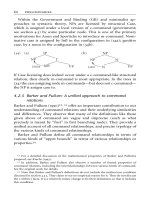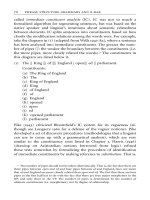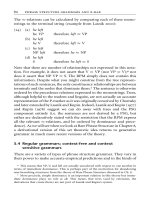Constituent structure andrew carnie
Bạn đang xem bản rút gọn của tài liệu. Xem và tải ngay bản đầy đủ của tài liệu tại đây (1.57 MB, 313 trang )
Constituent Structure
OXFORD SURVEYS IN SYNTAX AND MORPHOLOGY
general editor: Robert D. Van Valin, Jr, Heinrich-Heine Universita
¨
tDu
¨
sseldorf
& University at BuValo, State University of New York
advisory editors: Guglielmo Cinque, University of Venice; Daniel Everett,
Illinois State University; Adele Goldberg, Princeton University; Kees Hengeveld,
University of Amsterdam; Caroline Heycock, University of Edinburgh; David
Pesetsky, MIT; lan Roberts, University of Cambridge; Masayoshi Shibatani,
Rice University; Andrew Spencer, University of Essex; Tom Wasow, Stanford
University
published
1. Grammatical Relations
Patrick Farrell
2. Morphosyntactic Change
Olga Fischer
3. Information Structure: the Syntax-Discourse Interface
Nomi Erteschik-Shir
4. Computational Approaches to Syntax and Morphology
Brian Roark and Richard Sproat
5. Constituent Structure
Andrew Carnie
in preparation
The Acquisition of Syntax and Morphology
Shanley Allen and Heike Behrens
The Processing of Syntax and Morphology
Ina Bornkessel-Schlesewsky and Matthias Schlesewesky
Morphology and the Lexicon
Daniel Everett
The Phonology–Morphology Interface
Sharon Inkelas
The Syntax–Semantics Interface
Jean-Pierre Koenig
Complex Sentences
Toshio Ohori
Syntactic Categories
by Gisa Rauh
Language Universals and Universal Grammar
Anna Siewierska
Argument Structure: The Syntax–Lexicon Interface
Stephen Weschler
Constituent
Structure
ANDREW CARNIE
1
3
Great Clarendon Street, Oxford ox2 6dp
Oxford University Press is a department of the University of Oxford.
It furthers the University’s objective of excellence in research, scholarship,
and education by publishing worldwide in
Oxford New York
Auckland Cape Town Dar es Salaam Hong Kong Karachi
Kuala Lumpur Madrid Melbourne Mexico City Nairobi
New Delhi Shanghai Taipei Toronto
With oYces in
Argentina Austria Brazil Chile Czech Republic France Greece
Guatemala Hungary Italy Japan Poland Portugal Singapore
South Korea Switzerland Thailand Turkey Ukraine Vietnam
Oxford is a registered trade mark of Oxford University Press
in the UK and in certain other countries
Published in the United States
by Oxford University Press Inc., New York
ß Andrew Carnie 2008
The moral rights of the author have been asserted
Database right Oxford University Press (maker)
First published 2008 by Oxford University Press
All rights reserved. No part of this publication may be reproduced,
stored in a retrieval system, or transmitted, in any form or by any means,
without the prior permission in writing of Oxford University Press,
or as expressly permitted by law, or under terms agreed with the appropriate
reprographics rights organization. Enquiries concerning reproduction
outside the scope of the above should be sent to the Rights Department,
Oxford University Press, at the address above
You must not circulate this book in any other binding or cover
and you must impose the same condition on any acquirer
British Library Cataloguing in Publication Data
Data available
Library of Congress Cataloging in Publication Data
Data available
Typeset by SPI Publisher Services, Pondicherry, India
Printed in Great Britain
on acid-free paper by
Biddles Ltd., King’s Lynn, Norfolk
ISBN 978–0–19–926199–4 (Hbk.)
978–0–19–926200–7 (Pbk.)
13579108642
Contents
Acknowledgements x
General Preface xi
Abbreviations xii
Symbols Used xvi
Part 1. Preliminaries
1. Introduction 3
1.1. What this book is about 3
1.2. Organizational notes 4
1.3. Apples, oranges, and pears 5
1.4. Who I assume you are 7
2. Constituent Structure 8
2.1. Constituent structure as simple concatenation 8
2.2. Regular grammars 12
2.3. Constituent structure and constituency tes ts 17
2.4. Compositionality, modiWcation, and ambiguity 21
2.5. Some concluding thoughts 24
3. Basic Properties of Trees: Dominance and Precedence 25
3.1. Introduction 25
3.2. Tree structures 26
3.3. Dominance 29
3.3.1 Simple dominance 29
3.3.2 Axiomization of dominance 30
3.3.3 Immediate dominance 35
3.
3.4 Exhaustive dominance and ‘‘constituent’’ 36
3.4. Precedence 37
3.4.1 Intuitive characterizations of precedence 37
3.4.2 Immediate precedence 41
3.4.3 Axioms of precedence 41
3.5. Concluding remarks 44
4. Second Order Relations: C-command and Government 46
4.1. Introduction 46
4.2. Command, kommand, c-command, and m-command 46
4.2.1 Command and kommand (cyclic command) 47
4.2.2 C-command (constituent command) 49
4.2.3 Deriving and explaining c-command 55
4.2.4 M-command 58
4.2.5 Barker and Pullum (1990): A uniWed approach to
command relations 60
4.3. Government 63
4.4. Concluding remarks 65
Part 2. Phrase Structure Grammars and X-bar Theory
5. Capturing Constituent Structure: Phrase Structure
Grammars 69
5.1. Before the Chomskyan revolution: ConXating semantic
and structural relations 69
5.2. Phrase structure grammars 71
5.3. Phrase markers and reduced phrase markers 78
5.4. Regular grammars; context-free and context sensitive
grammars 80
5.4.1 Regular grammars 81
5.4.2 Context-free and context-sensitive
phrase structure grammars 83
5.5. The recursive nature of phrase structure grammars 84
5.6. The ontology of PSRs and trees 86
5.7. The information contained in PSRs 90
6. Extended Phrase Structure Grammars 93
6.1. Introduction 93
6.2. Some minor abbreviatory conventions in PSGs 94
6.3. Transformations 96
6.3.1 Structure-changing transformations 96
6.3.2 Generalized transformations 97
vi contents
6.4. Features and feature structures 98
6.4.1 The use of features in Generalized Phrase
Structure Grammar 100
6.5. Metarules 103
6.6. Linear Precedence vs. Immediate Dominance Rules 105
6.7. Meaning postulates (GPSG), f-structures and
metavariables (LFG) 106
6.7.1 Meaning postulates in GPSG 106
6.7.2 Functional equations, f-structures, and
metavariables in LFG 107
6.7.3 Summary 110
6.8. The lexicon 110
6.9. Conclusion 111
7. X-bar Theory 112
7.1. Introduction 112
7.2. Simple PSGs vs. X-bar theoretic PSGs 112
7.2.1 Headedness 112
7.2.2 Structural reWnement 114
7.2.3 Binarity 120
7.2.
4 Distinctions among modiWer types 121
7.2.5 Cross-linguistic variation 128
7.2.6 Summary 129
7.3. A short history of X-bar theory 129
7.3.1 The origins: Harris (1951) and Chomsky (1970) 129
7.3.2 Early controversies: Emonds (1976), JackendoV
(1977), Stuurman (1984) 130
7.3.3 A major conceptual shift: metagrammar
vs. grammar: Stowell (1981) 131
7.4. Summary 132
Part 3. Controversies
8. Towards Set-Theoretic Constituency Representations 135
8.1. Introduction 135
8.2. Projections and derived X-bar theory 136
contents vii
8.3. Antisymmetry 144
8.3.1 The LCA and linear ordering 145
8.3.2 Deriving some X-bar theoretic properties
from the LCA 149
8.3.3 Adjunction 150
8.4. Bare Phrase Structure 154
8.4.1 The basics of BPS 155
8.4.2 Adjunction in BPS 158
8.4.3 Bottom-to-top and top-to-bottom derivations 160
8.4.3.1 Bottom-to-top derivations 161
8.4.3.2 Top-to-bottom derivations 161
8.4.4 Derived X-bar theory 163
8.4.5 Label-free and projection-free structures 167
9. Dependency and Constituency 168
9.1. Introduction 168
9.2. Systems based primarily on grammatical relations 171
9.2
.1 A semi-arboreal system: Lexical-Functional
Grammar 171
9.2.2 Relational Grammar 172
9.3. Dependency grammars 175
9.4. Categorial grammars 178
9.4.1 Classic Categorial Grammar and Combinatorial
Categorial Grammar 179
9.4.2 Tree-Adjoining Grammar (TAG) 183
9.4.3 Features in HPSG 185
9.5. Functionalist Grammar and Role and Reference
Grammar 186
9.6. Construction Grammar and Cognitive Grammar 187
10. Multidominated, Multidimensional, and
Multiplanar Structures 189
10.1. Introduction 189
10.2. Line crossing and multidomination: axiomatic
restrictions on form 195
viii contents
10.2.1 The non-tangling–exclusivity controversy 195
10.2.2 C-command and the non-tangling condition 200
10.3. Multidomination and multidimensional trees 204
10.4. Multiplanar structures 207
10.4.1 Parallel plane hypotheses: Classic
Transformational Grammar, LFG,
Simpler Syntax 208
10.4.2 The Parallel Plane hypotheses: L- and S-Syntax
and pheno- and tectogrammatical structures 209
10.4.3 Wheel-and-spoke multiplanar approaches 212
10.5. Conclusions 217
11. Phrasal Categories and Cartography 219
11.1. Introduction 219
11.2. The tripartite structure of the clause 221
11.3. The VP 222
11.3.1 Classic constituency tests 223
11.3.2 VSO languages as evidence against VPs 226
11.3.3 The VP-internal subject Hypothesis (VPISH) 234
11.3.4 Stacked VPs, Split VPs, vP 237
11.4
. The clausal layer 242
11.5. The informational layer 250
11.5.1 S’ and CP 251
11.5.2 Expanded CP 253
11.6. Negation and adver bials 256
11.6.1 Negation 256
11.6.2 Adverbs 258
11.7. NPs and DPs 259
11.8. Concluding remarks 260
References 261
Index 287
contents ix
Acknowledgements
This book has beneWted from the input, advice, and feedback
from a number of people, ranging from answering simple email quer-
ies to reading all or some of the manuscript. Here’s a partial list,
in alphabetical order: Anne Abeille
´
, Ash Asudeh Andy Barss,
Bob Berwick, Tom Bever, Sherrylyn Branchaw, Jean Carnie, Fiona
Carnie, Morag Carnie, Robert Carnie, Robert Chametzky, Noam
Chomsky, John Davey, Andrea Dauer, Malcolm Elliott, Yehuda Falk,
Georgia Green, Heidi Harley, Michael Hammond, Richard Hudson,
Peter Kahrel, Tibor Kiss, Simin Karimi, Tracy Holliway King, Terry
Langendoen, Shalom Lappin, Howard Lasnik, Tel Monks, David
P. Medeiros, Stefan Mu
¨
ller, David Pesetsky, Massimo Piatelli-Palmar-
ini, Chloe Plummer, Carl Pollard, GeoV Pullum, Sumayya Racy, Ivan
Sag, Maggie Shade, Yosuke Sato, Robert Van Valin, Steve Weschler.
Thanks to you all. Special thanks go to my family who let me work on
this book while ignoring them over the 2006 winter holidays.
AC
Tucson, February 2007
General Preface
Oxford Surveys in Syntax and Morpholog y provides overviews of the
major approaches to subjects and questions at the centre of linguistic
research in morphology and syntax. The volumes are accessible, crit-
ical, and up-to-date. Individually and collectively they aim to reveal
the Weld’s intellectual history and theoretical diversity. Each book
published in the series will characterist ically contain: (1) a brief histor-
ical overview of relevant research in the subject; (2) a critical presen-
tation of approaches from relevant (but usually seen as competing)
theoretical perspectives to the phenomena and issues at hand, includ-
ing an objective evaluation of the strengths and weaknesses of each
approach to the central problems and issues; (3 ) a balanced account of
the current issues, problems, and opportunities relating to the topic,
showing the degree of consensus or otherwise in each case. The
volumes will thus provide researchers and graduate students con-
cerned with syntax, morphology, and related aspects of grammar,
communication, and cognition with a vital source of information
and reference.
Andrew Carnie’s Constituent St ructure surveys one of the most
fundamental areas of syntax. It encompasses a variety of views and
proposals, both within the Chomskyan tradition and outside of it, and
in this regard it is a quite unique and valuable contribution to the
study of syntax.
Robert D. Van Valin, Jr
General Editor
University at BuValo, The State University of New York
Heinrich Heine University, Du
¨
sseldorf
Abbreviations
3rd third person
A movement Argument movement (same as NP movement)
A answer
A-bar movement non-argument movement (typically the same as
wh-movement)
Adj’ ‘‘Adjective bar’’, intermediate adjective category
Adj Adjective
AdjP Adjective Phrase
Adv’ ‘‘Adverb bar’’, intermediate adverb category
Adv Adverb
AdvP Adverb Phrase
AFD in RRG, actual focus domain
agreement agreement feature
AgrIO Indirect object functional projection
AgrIOP Indirect object Agreement Phrase
AgrO Object agreement functional projection
AgrOP Object agreement Phrase
AgrS Subject agreement functional projection
AgrSP Subject agreement Phrase
ARG in RRG, arguments
Aux Auxiliary
AVM attribute value matrix
bar bar-level feature
BPS Bare Phrase Structure
C’ ‘‘Complementizer bar’’, intermediate complemen-
tizer category
C Complementizer
category category feature
CF context free
cho
ˆ
cho
ˆ
meur (relational grammar)
comps complement feature
Condition A the requirement that an anaphor must be bound in
a local domain
Condition B the requirement that a pronoun must not be
bound in a local domain
Condition C the requirement that an R-expression must not be
bound
Conj Conjunction
COP copula
CP Complementizer Phrase (¼ S’)
CS context sensitive
D’ ‘‘Determiner bar’’, intermediate determiner
category
D Determiner
DAG directed acyclic graphs
def deWniteness
DOM Domain-of-word-order feature in HPSG
DP Determiner Phrase
DTRS daughters feature in HPSG
ECPO Exhaustive Constant Partial Ordering
EPP Extended Projection Principle
EST Extended Standard Theory
FCR Feature Co-occurence Restriction
FFP Foot-Feature Principle
fin Finite
Foc Focus
FSA Wnite-state automata
FSD feature-speciWcation defaults
GB Government and Binding Theory
gender gender feature
GKPS Gazdar, Klein, Pullum, and Sag (1983)
GPSG Generalized Phrase Structure Grammar
GT generalized transformation
HFC Head Feature Convention
HPSG Head-driven Phrase Structure Grammar
IC immediate constituent
ID/LP immediate dominance/linear precedence
IDC immediate dominance c-command
IF in RRG, Intentional Force
InX the functional category of InXection, later
replaced by Agr, AgrS, AgrO, TP
inv inversion feature
IP InXectional Phrase (often the same as TP or S)
label set of category labels
abbreviations xiii
LCA Linear Correspondence Axiom
LCS in RRG, the layered structure of the clause
LF Logical Form
LFG Lexical-Functional Grammar
LSLT Logical Structure of Linguistic Theory
M mothership relation/immediate domination
max set of XP categories
MP Minimalist Program
MSO Monadic Second Order
MTS Model-Theoretic Syntax
MUB Minimal Upper Bound
N’ ‘‘Noun bar’’, intermediate noun category
N Noun
Neg Negation
NP Noun Phrase
NUC in RRG, the nucleus of the CORE
num number feature
obj in LFG, object function
OSV Object-Subject-Verb order
OVS Object-Verb-Subject order
P’ ‘‘Preposition bar’’, intermediate preposition cat-
egory
P Preposition
P&P Principles and Parameters Theory
person person feature
PF Phonetic/Phonological Form
PFD in RRG, potential Focus Domain
PM phrase marker
PP Prepositional Phrase
PRED in RRG, the predicate; in LFG, the predicative
content of the f-structure
PSG phrase structure grammar
PSR phrase structure rule
Q Question
QP QuantiWer Phrase
R-expression referring expression (most nouns, excluding pro-
nouns, anaphors, and other elements that typically
get their reference from linguistic context)
RG Relational Grammar
xiv abbreviations
RRG Role and Reference Grammar
S Sentence (often ¼ IP or TP)
S’ ‘‘S-bar’’ (¼ CP)
SAI Subject-Aux Inversion
SCT structure-changing transformation
slash ‘‘slash feature’’ (indicates a gap in structure)
SOV Subject-Object-Verb order
subcat subcategorization feature
subj in LFG, subject function
SVO Subject-Verb-Object order
T’ ‘‘Tense bar’’, intermediate tense category
T Tense functional projection
TAG Tree-Adjoining Grammar
TG Transformational Grammar
Tns in RRG, tense
Top Topic
TP Tense Phrase (often the same as S)
UB upper bound
v ‘‘little v’’ or ‘‘light v’’
V’ ‘‘Verb bar’’, intermediate verb category
V verb
VOS Verb-Object-Subject order
vP ‘‘little v’’ phrase
VP Verb Phrase
VPISH VP-internal Subject Hypothesis
VSO Verb-Subject-Object order
X’ some intermediate category headed by category X
X’’ ‘‘X double bar’’, usually equivalent to XP or X
max
X
o
head (word) indicating category X
xcomp in LFG, predicate complement
X
max
maximal (usually phrasal) category associated
with category X, usually equal to X’’ and XP
X
P
a node of category X, of indeterminate phrasality
XP some maximal/phrasal categor y headed by cat-
egory X, often equivalent to X’’ and X
max
abbreviations xv
Symbols Used
# Before an example sentence, indicates semantic oddity
Or pragmatic infelicity.
& Conjunction (and)
_ Disjunction (or)
: Negation (‘‘it is not the case that’’)
! Two uses: (a) in logical formula: conditional (if
then); (b) in phrase structure grammars ! means
‘‘rewrites as’’, ‘‘projects from’’, ‘‘consists of ’’ or ‘‘is li-
censed by’’, depending upon the approach.
$ Biconditional (if and only if)
8 Universal quantiWer (every)
9 Existential quantiWer (some)
List addition
() In phrase structure rules indicates optionality. In syn-
tactic forms may indicate structure. In logical forms
may indicate functional application or structure, as in
the usual usages.
("subj)¼# In LFG, metavariable indicating node bears subject role
of dominating category (similarly for (" obj)¼#, etc.)
"¼# In LFG, metavariable indicating featural identity be-
tween node and dominating category
* Kleene star. In phrase structure rules, indicates zero or
more. Before an example, indicates ungrammaticality.
/ _____ In phrase structure rules, ‘‘_____ is in the context of’’
? Before an example sentence, indicates marginal gram-
maticality.
[] Constituent boundaries
^ Span; in the right-wrap rule, indicates linear concaten-
ation
{NP/CP} In phrase structure rules, indicates choice between NP
and CP.
{x, y} Unordered set of x and y
j Such that (in set descriptions); boundary in immediate
constituent analysis
Approximately
þ Kleene plus. In phrase structure rules, indicates one or
more. In other contexts, indicates addition.
<A Rule of Backward Application (Combinatorial Categor-
ial Grammar)
hx, yi Ordered set of x and y
Precedence
s
Sister precedence
¼ Equals
¼
def
Is deWned as
> Greater than
>A Rule of forward application (Combinatorial Categorial
Grammar)
+ Plus or minus in binary feature values
2 Element of (set membership)
[ Set union
‘‘Is a’’ relation
6¼ Does not equal
# Lesser than or equal too
$ Greater than or equal to
Used in feature coocurrence restrictions (FCRs) for
‘‘entails’’ or ‘‘requires’’
/ Immediate domination
/* Domination
/
þ
Proper domination
) In TG, this indicates a structure changing transform-
ation; in GPSG it indicates the application of a meta-
rule or a meaning postulate.
a, b, c, . . . Constants
i, j, k, l, . . . Indices
w, x, y, z, . . . variables
N Set of non-terminals
NP# Substitute an NP in this position. (Tree-Adjoining
Grammar)
P Set of production rules
S Star t symbol
S/NP In Combinatorial Categorial Grammar, look right for
an NP to form an S.
S\NP In Combinatorial Categorial Grammar, look left for an
NP to form an S.
symbols xvii
T Set of terminals
ºx Lambda operator (indicates following string is an open
function unspeciWed for x)
P Projection path
SP Polarit y Phrase
xviii symbols
Proper words in proper places . . .
Jonathan Swift, Letter to a Young Clergyman, 9 January 1720
This page intentionally left blank
Part 1
Preliminaries
This page intentionally left blank
1
Introduction
1.1 What this book is about
The study of phrase or constituent structure explores the combination
of words into phrases and sentences. Constituent structure provides
the roadmap that determines which words can be combined with
which other words. This book is about the many, and varied, attempts
to explain how word combination occurs.
An old, but important, observation about sentences is that they are
not merely a linear string of words. There appears, even at an intuitive
level, to be some organization that links some words more closely
together than others. Take, for example, the sentence in (1):
(1) My cat eats at really fancy restaurants.
In terms of interpretation, the relationship between really and fancy
seems to be closer than that between eats and at. The word really tells us
about how fancy the restaurants are, whereas the semantic relationship
between eat and at seems to be mediated by the more distant words
fancy and restaurants—this despite the fact that in terms of linear order
the relationship between eat at and really fancy is identical—in each
case the words are adjacent. In the structuralist tradition, whether
instantiated in a formalist or functionalist framework, this kind of
closeness is indicated by ‘‘phrase’’ (or ‘‘constituent’’) structure. The
graphic representation of phrase structure has about as many variants
as there are theories about syntax, but roug hly converge on structures
like those given in (2) as a tree (a) or a bracketed diagram (b):
(a)
My cat eats at
really
fancy restaurants
(b)
[[m
y
cat][eats [at [[reall
y
fanc
y
] restaurants]]]]
Although there is a great deal of controversy over even these simple
diagrams (whether there is a verb phrase category, what the nature of
each of the larger groups of words is, what labeling mechanisms are
appropriate, etc.) all these structures capture the fact that there is some
closer relationship between really and fancy than between eats and at.
As Wrst observed by BloomWeld (1933), such semantically based
grouping of words seems to correlate with the way these groups
function with respect to syntactic processes. Compare, for example,
the grouped constituent [eats at really fan cy restaurants] to the non-
constituent [eats at really]. The Wrst group can stand alone in answer to
a question. The second cannot:
(3) Q. What does your cat do when you’re on vacation?
(a) Eat at really fancy restaurants.
(b) *Eat at really.
The Wrst group can be replaced by do so, the second cannot:
(4) My cat eats at really fancy restaurants . . .
(a) . . . and my goldWsh [does too].
(b) * . . . and my goldWsh [does too] fancy restaurants.
Finally, the Wrst group can be dislocated in the sentence, but the second
cannot:
(5) (a) Eating at really fancy restaurants, that’s what my cat likes to
do.
(b) *Eating at really, that’s what my cat likes to do (fancy
restaurants).
These facts are fairly robust and require an account.
1.2 Organizational notes
In this book, I survey the current thinking, both cross-linguistically
and cross-theoretically, on the topic of constituent structure. In the
next few chapters, I review some fundamentals of constituent structure.
In Chapter 2, I present the basic empirical evidence for constituent
structure (constituency tests), and I discuss the related notions of
compositionality and ambiguity. We will see that simple theories of
concatenation fail to capture the basic facts about phrase structure and
that a hierarchical approach is necessary. However, we will also see that
constituency tests do not always give uniform results about what the
structure of a particular sentence is. Chapters 3 and 4 also cover some
4 prelimin aries









